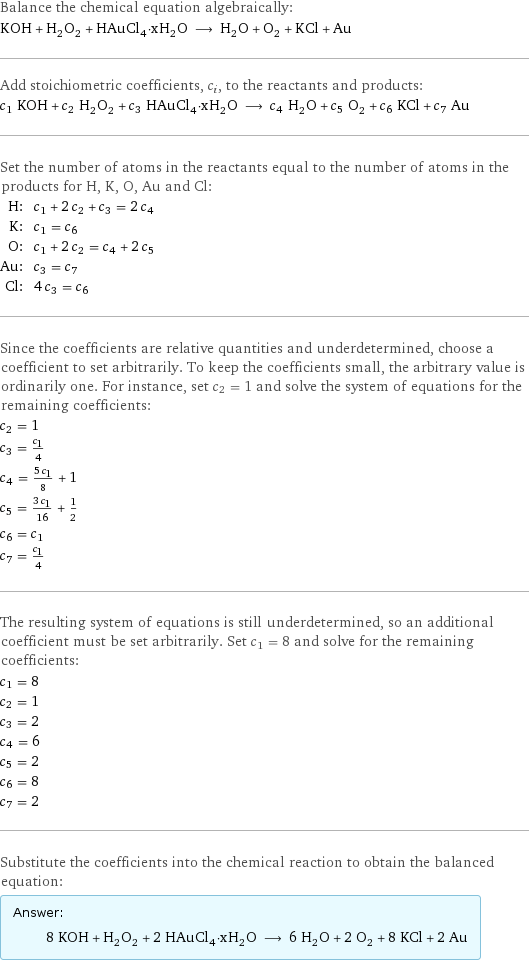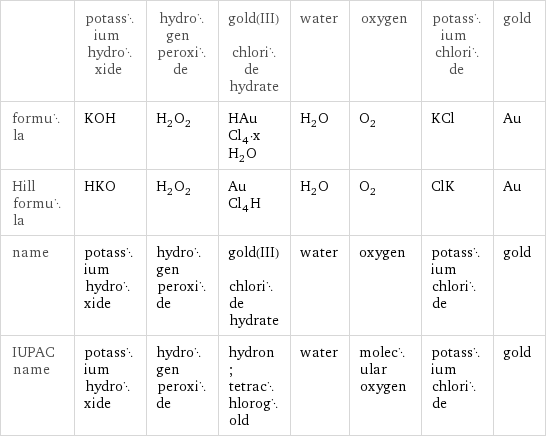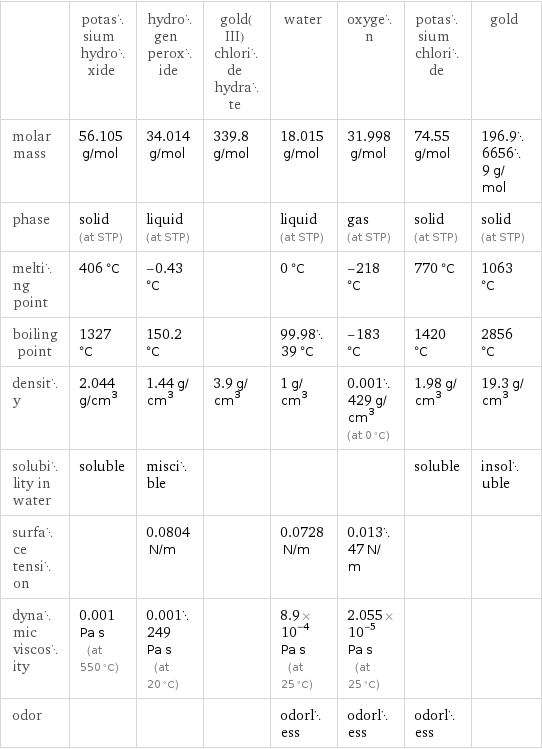Input interpretation

KOH potassium hydroxide + H_2O_2 hydrogen peroxide + HAuCl_4·xH_2O gold(III) chloride hydrate ⟶ H_2O water + O_2 oxygen + KCl potassium chloride + Au gold
Balanced equation

Balance the chemical equation algebraically: KOH + H_2O_2 + HAuCl_4·xH_2O ⟶ H_2O + O_2 + KCl + Au Add stoichiometric coefficients, c_i, to the reactants and products: c_1 KOH + c_2 H_2O_2 + c_3 HAuCl_4·xH_2O ⟶ c_4 H_2O + c_5 O_2 + c_6 KCl + c_7 Au Set the number of atoms in the reactants equal to the number of atoms in the products for H, K, O, Au and Cl: H: | c_1 + 2 c_2 + c_3 = 2 c_4 K: | c_1 = c_6 O: | c_1 + 2 c_2 = c_4 + 2 c_5 Au: | c_3 = c_7 Cl: | 4 c_3 = c_6 Since the coefficients are relative quantities and underdetermined, choose a coefficient to set arbitrarily. To keep the coefficients small, the arbitrary value is ordinarily one. For instance, set c_2 = 1 and solve the system of equations for the remaining coefficients: c_2 = 1 c_3 = c_1/4 c_4 = (5 c_1)/8 + 1 c_5 = (3 c_1)/16 + 1/2 c_6 = c_1 c_7 = c_1/4 The resulting system of equations is still underdetermined, so an additional coefficient must be set arbitrarily. Set c_1 = 8 and solve for the remaining coefficients: c_1 = 8 c_2 = 1 c_3 = 2 c_4 = 6 c_5 = 2 c_6 = 8 c_7 = 2 Substitute the coefficients into the chemical reaction to obtain the balanced equation: Answer: | | 8 KOH + H_2O_2 + 2 HAuCl_4·xH_2O ⟶ 6 H_2O + 2 O_2 + 8 KCl + 2 Au
Structures

+ + ⟶ + + +
Names

potassium hydroxide + hydrogen peroxide + gold(III) chloride hydrate ⟶ water + oxygen + potassium chloride + gold
Equilibrium constant
![Construct the equilibrium constant, K, expression for: KOH + H_2O_2 + HAuCl_4·xH_2O ⟶ H_2O + O_2 + KCl + Au Plan: • Balance the chemical equation. • Determine the stoichiometric numbers. • Assemble the activity expression for each chemical species. • Use the activity expressions to build the equilibrium constant expression. Write the balanced chemical equation: 8 KOH + H_2O_2 + 2 HAuCl_4·xH_2O ⟶ 6 H_2O + 2 O_2 + 8 KCl + 2 Au Assign stoichiometric numbers, ν_i, using the stoichiometric coefficients, c_i, from the balanced chemical equation in the following manner: ν_i = -c_i for reactants and ν_i = c_i for products: chemical species | c_i | ν_i KOH | 8 | -8 H_2O_2 | 1 | -1 HAuCl_4·xH_2O | 2 | -2 H_2O | 6 | 6 O_2 | 2 | 2 KCl | 8 | 8 Au | 2 | 2 Assemble the activity expressions accounting for the state of matter and ν_i: chemical species | c_i | ν_i | activity expression KOH | 8 | -8 | ([KOH])^(-8) H_2O_2 | 1 | -1 | ([H2O2])^(-1) HAuCl_4·xH_2O | 2 | -2 | ([HAuCl4·xH2O])^(-2) H_2O | 6 | 6 | ([H2O])^6 O_2 | 2 | 2 | ([O2])^2 KCl | 8 | 8 | ([KCl])^8 Au | 2 | 2 | ([Au])^2 The equilibrium constant symbol in the concentration basis is: K_c Mulitply the activity expressions to arrive at the K_c expression: Answer: | | K_c = ([KOH])^(-8) ([H2O2])^(-1) ([HAuCl4·xH2O])^(-2) ([H2O])^6 ([O2])^2 ([KCl])^8 ([Au])^2 = (([H2O])^6 ([O2])^2 ([KCl])^8 ([Au])^2)/(([KOH])^8 [H2O2] ([HAuCl4·xH2O])^2)](../image_source/1cef8eb18cb9120b1617d67e8a2057d1.png)
Construct the equilibrium constant, K, expression for: KOH + H_2O_2 + HAuCl_4·xH_2O ⟶ H_2O + O_2 + KCl + Au Plan: • Balance the chemical equation. • Determine the stoichiometric numbers. • Assemble the activity expression for each chemical species. • Use the activity expressions to build the equilibrium constant expression. Write the balanced chemical equation: 8 KOH + H_2O_2 + 2 HAuCl_4·xH_2O ⟶ 6 H_2O + 2 O_2 + 8 KCl + 2 Au Assign stoichiometric numbers, ν_i, using the stoichiometric coefficients, c_i, from the balanced chemical equation in the following manner: ν_i = -c_i for reactants and ν_i = c_i for products: chemical species | c_i | ν_i KOH | 8 | -8 H_2O_2 | 1 | -1 HAuCl_4·xH_2O | 2 | -2 H_2O | 6 | 6 O_2 | 2 | 2 KCl | 8 | 8 Au | 2 | 2 Assemble the activity expressions accounting for the state of matter and ν_i: chemical species | c_i | ν_i | activity expression KOH | 8 | -8 | ([KOH])^(-8) H_2O_2 | 1 | -1 | ([H2O2])^(-1) HAuCl_4·xH_2O | 2 | -2 | ([HAuCl4·xH2O])^(-2) H_2O | 6 | 6 | ([H2O])^6 O_2 | 2 | 2 | ([O2])^2 KCl | 8 | 8 | ([KCl])^8 Au | 2 | 2 | ([Au])^2 The equilibrium constant symbol in the concentration basis is: K_c Mulitply the activity expressions to arrive at the K_c expression: Answer: | | K_c = ([KOH])^(-8) ([H2O2])^(-1) ([HAuCl4·xH2O])^(-2) ([H2O])^6 ([O2])^2 ([KCl])^8 ([Au])^2 = (([H2O])^6 ([O2])^2 ([KCl])^8 ([Au])^2)/(([KOH])^8 [H2O2] ([HAuCl4·xH2O])^2)
Rate of reaction
![Construct the rate of reaction expression for: KOH + H_2O_2 + HAuCl_4·xH_2O ⟶ H_2O + O_2 + KCl + Au Plan: • Balance the chemical equation. • Determine the stoichiometric numbers. • Assemble the rate term for each chemical species. • Write the rate of reaction expression. Write the balanced chemical equation: 8 KOH + H_2O_2 + 2 HAuCl_4·xH_2O ⟶ 6 H_2O + 2 O_2 + 8 KCl + 2 Au Assign stoichiometric numbers, ν_i, using the stoichiometric coefficients, c_i, from the balanced chemical equation in the following manner: ν_i = -c_i for reactants and ν_i = c_i for products: chemical species | c_i | ν_i KOH | 8 | -8 H_2O_2 | 1 | -1 HAuCl_4·xH_2O | 2 | -2 H_2O | 6 | 6 O_2 | 2 | 2 KCl | 8 | 8 Au | 2 | 2 The rate term for each chemical species, B_i, is 1/ν_i(Δ[B_i])/(Δt) where [B_i] is the amount concentration and t is time: chemical species | c_i | ν_i | rate term KOH | 8 | -8 | -1/8 (Δ[KOH])/(Δt) H_2O_2 | 1 | -1 | -(Δ[H2O2])/(Δt) HAuCl_4·xH_2O | 2 | -2 | -1/2 (Δ[HAuCl4·xH2O])/(Δt) H_2O | 6 | 6 | 1/6 (Δ[H2O])/(Δt) O_2 | 2 | 2 | 1/2 (Δ[O2])/(Δt) KCl | 8 | 8 | 1/8 (Δ[KCl])/(Δt) Au | 2 | 2 | 1/2 (Δ[Au])/(Δt) (for infinitesimal rate of change, replace Δ with d) Set the rate terms equal to each other to arrive at the rate expression: Answer: | | rate = -1/8 (Δ[KOH])/(Δt) = -(Δ[H2O2])/(Δt) = -1/2 (Δ[HAuCl4·xH2O])/(Δt) = 1/6 (Δ[H2O])/(Δt) = 1/2 (Δ[O2])/(Δt) = 1/8 (Δ[KCl])/(Δt) = 1/2 (Δ[Au])/(Δt) (assuming constant volume and no accumulation of intermediates or side products)](../image_source/dcf746dfc84b4b9d2c9c16bd26ba638f.png)
Construct the rate of reaction expression for: KOH + H_2O_2 + HAuCl_4·xH_2O ⟶ H_2O + O_2 + KCl + Au Plan: • Balance the chemical equation. • Determine the stoichiometric numbers. • Assemble the rate term for each chemical species. • Write the rate of reaction expression. Write the balanced chemical equation: 8 KOH + H_2O_2 + 2 HAuCl_4·xH_2O ⟶ 6 H_2O + 2 O_2 + 8 KCl + 2 Au Assign stoichiometric numbers, ν_i, using the stoichiometric coefficients, c_i, from the balanced chemical equation in the following manner: ν_i = -c_i for reactants and ν_i = c_i for products: chemical species | c_i | ν_i KOH | 8 | -8 H_2O_2 | 1 | -1 HAuCl_4·xH_2O | 2 | -2 H_2O | 6 | 6 O_2 | 2 | 2 KCl | 8 | 8 Au | 2 | 2 The rate term for each chemical species, B_i, is 1/ν_i(Δ[B_i])/(Δt) where [B_i] is the amount concentration and t is time: chemical species | c_i | ν_i | rate term KOH | 8 | -8 | -1/8 (Δ[KOH])/(Δt) H_2O_2 | 1 | -1 | -(Δ[H2O2])/(Δt) HAuCl_4·xH_2O | 2 | -2 | -1/2 (Δ[HAuCl4·xH2O])/(Δt) H_2O | 6 | 6 | 1/6 (Δ[H2O])/(Δt) O_2 | 2 | 2 | 1/2 (Δ[O2])/(Δt) KCl | 8 | 8 | 1/8 (Δ[KCl])/(Δt) Au | 2 | 2 | 1/2 (Δ[Au])/(Δt) (for infinitesimal rate of change, replace Δ with d) Set the rate terms equal to each other to arrive at the rate expression: Answer: | | rate = -1/8 (Δ[KOH])/(Δt) = -(Δ[H2O2])/(Δt) = -1/2 (Δ[HAuCl4·xH2O])/(Δt) = 1/6 (Δ[H2O])/(Δt) = 1/2 (Δ[O2])/(Δt) = 1/8 (Δ[KCl])/(Δt) = 1/2 (Δ[Au])/(Δt) (assuming constant volume and no accumulation of intermediates or side products)
Chemical names and formulas

| potassium hydroxide | hydrogen peroxide | gold(III) chloride hydrate | water | oxygen | potassium chloride | gold formula | KOH | H_2O_2 | HAuCl_4·xH_2O | H_2O | O_2 | KCl | Au Hill formula | HKO | H_2O_2 | AuCl_4H | H_2O | O_2 | ClK | Au name | potassium hydroxide | hydrogen peroxide | gold(III) chloride hydrate | water | oxygen | potassium chloride | gold IUPAC name | potassium hydroxide | hydrogen peroxide | hydron; tetrachlorogold | water | molecular oxygen | potassium chloride | gold
Substance properties

| potassium hydroxide | hydrogen peroxide | gold(III) chloride hydrate | water | oxygen | potassium chloride | gold molar mass | 56.105 g/mol | 34.014 g/mol | 339.8 g/mol | 18.015 g/mol | 31.998 g/mol | 74.55 g/mol | 196.966569 g/mol phase | solid (at STP) | liquid (at STP) | | liquid (at STP) | gas (at STP) | solid (at STP) | solid (at STP) melting point | 406 °C | -0.43 °C | | 0 °C | -218 °C | 770 °C | 1063 °C boiling point | 1327 °C | 150.2 °C | | 99.9839 °C | -183 °C | 1420 °C | 2856 °C density | 2.044 g/cm^3 | 1.44 g/cm^3 | 3.9 g/cm^3 | 1 g/cm^3 | 0.001429 g/cm^3 (at 0 °C) | 1.98 g/cm^3 | 19.3 g/cm^3 solubility in water | soluble | miscible | | | | soluble | insoluble surface tension | | 0.0804 N/m | | 0.0728 N/m | 0.01347 N/m | | dynamic viscosity | 0.001 Pa s (at 550 °C) | 0.001249 Pa s (at 20 °C) | | 8.9×10^-4 Pa s (at 25 °C) | 2.055×10^-5 Pa s (at 25 °C) | | odor | | | | odorless | odorless | odorless |
Units
